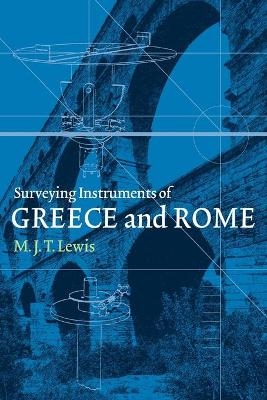
Surveying Instruments of Greece and Rome
Seiten
2009
Cambridge University Press (Verlag)
978-0-521-11065-5 (ISBN)
Cambridge University Press (Verlag)
978-0-521-11065-5 (ISBN)
This book contains translations of all the ancient texts on surveying, including major sources hitherto untapped. It sets out to reconstruct the instruments and to explain how they were used. A level of technical sophistication emerges, which must count as one of the greatest achievements of the ancient world.
The Greeks and, especially, the Romans are famous for the heroic engineering of their aqueducts, tunnels and roads. They also measured the circumference of the earth and the heights of mountains with fair precision. This book presents new translations (from Greek, Latin, Arabic, Hebrew and Syriac) of all the ancient texts concerning surveying, including major sources hitherto untapped. It explores the history of surveying instruments, notably the Greek dioptra and the Roman libra, and with the help of tests with reconstructions explains how they were used in practice. This is a subject which has never been tackled before in anything like this depth. The Greeks emerge as the pioneers of instrumental surveying and, though their equipment and methods were simple by modern standards, they and the Romans can be credited with a level of technical sophistication which must count as one of the greatest achievements of the ancient world.
The Greeks and, especially, the Romans are famous for the heroic engineering of their aqueducts, tunnels and roads. They also measured the circumference of the earth and the heights of mountains with fair precision. This book presents new translations (from Greek, Latin, Arabic, Hebrew and Syriac) of all the ancient texts concerning surveying, including major sources hitherto untapped. It explores the history of surveying instruments, notably the Greek dioptra and the Roman libra, and with the help of tests with reconstructions explains how they were used in practice. This is a subject which has never been tackled before in anything like this depth. The Greeks emerge as the pioneers of instrumental surveying and, though their equipment and methods were simple by modern standards, they and the Romans can be credited with a level of technical sophistication which must count as one of the greatest achievements of the ancient world.
Introduction; Part I. Instruments and Methods: 1. The basic elements; 2. Background to the dioptra; 3. The dioptra; 4. The libra; 5. The groma; 6. The hodometer; Part II. Practical Applications: 7. Measurement of the earth; 8. Mountain heights; 9. Canals and aqueducts; 10. Tunnels; 11. Roman roads; 12. Epilogue; Part III. The Sources: The treatises; Other sources; Appendix. Uncertain devices.
| Erscheint lt. Verlag | 7.5.2009 |
|---|---|
| Zusatzinfo | 6 Halftones, unspecified |
| Verlagsort | Cambridge |
| Sprache | englisch |
| Maße | 152 x 229 mm |
| Gewicht | 600 g |
| Themenwelt | Geschichte ► Allgemeine Geschichte ► Vor- und Frühgeschichte |
| Geisteswissenschaften ► Geschichte ► Regional- / Ländergeschichte | |
| Geschichte ► Teilgebiete der Geschichte ► Technikgeschichte | |
| Technik ► Bauwesen | |
| ISBN-10 | 0-521-11065-3 / 0521110653 |
| ISBN-13 | 978-0-521-11065-5 / 9780521110655 |
| Zustand | Neuware |
| Haben Sie eine Frage zum Produkt? |
Mehr entdecken
aus dem Bereich
aus dem Bereich
auf den Spuren der frühen Zivilisationen
Buch | Hardcover (2023)
C.H.Beck (Verlag)
20,00 €
Konzepte – Methoden – Theorien
Buch | Softcover (2024)
UTB (Verlag)
39,90 €
Was Pompeji über uns erzählt
Buch | Hardcover (2023)
Propyläen (Verlag)
32,00 €


